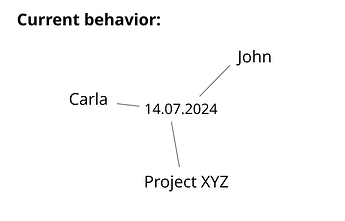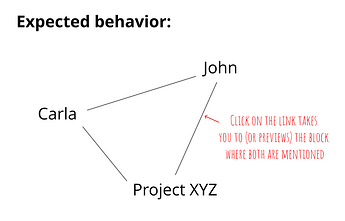I’ve been using Logseq for a couple of years, and I was never able to use the graph view for anything meaningful. There’s a conceptual gap that keeps puzzling me, between how Logseq is intended (or recommended) to be used and what the graph seems to be doing.
I use journal pages for everything, with a typical structure like this:
[[14.07.2024]]
* #meeting with [[Carla]]
* She points out that [[John]] is working in [[Project XYZ]]
The #meeting block lives in the journal page. There’s usually no content in any of the other referenced pages (apart from properties). I use the “linked references” section in those pages to filter their mentions. So I can enter the [[John] page and in the references I will see him related to [[Project XYZ]], and even filter all the occurrences where they are both mentioned together. Neat!
So far, it’s a pretty default, Logseq-y workflow, right? I mean, even the name of the app incites you to “log stuff sequentially” in the journal.
BUT.
Enter the graph view, and you will see that…
… it only shows links between pages, not blocks. So, [[Project XYZ]], [[Carla]] and [[John]] will appear as linked to the journal page [[14.07.2024]], but not to each other. How is that helping me understand relations between those pages, which are connected via mentions in blocks?
If this app is intended to be used through linked mentions in journal blocks but the graph does’t show those links, what’s the point of the graph view? As you can see above, I’m not able to tell if those pages are related to each other or just mentioned as separate things in the journal.
My expectation would be to see in the graph a link between [[John]] and [[Project XYZ]], and another (maybe lighter, indirect) link of both of those with [[Carla]], who mentioned them. But for me to see a link between them in the graph view, in reality they would need to be mentioned in the body of their respective pages. And that would entirely defeat the whole journal workflow.
Am I the only one perceiving a clash of workflows and concepts here? Why have the graph show only [[page1]]-to-[[page2]] links when the relations are usually [[page1]]-to-((block))-to-[[page2]]?
Is there something I’m missing?

